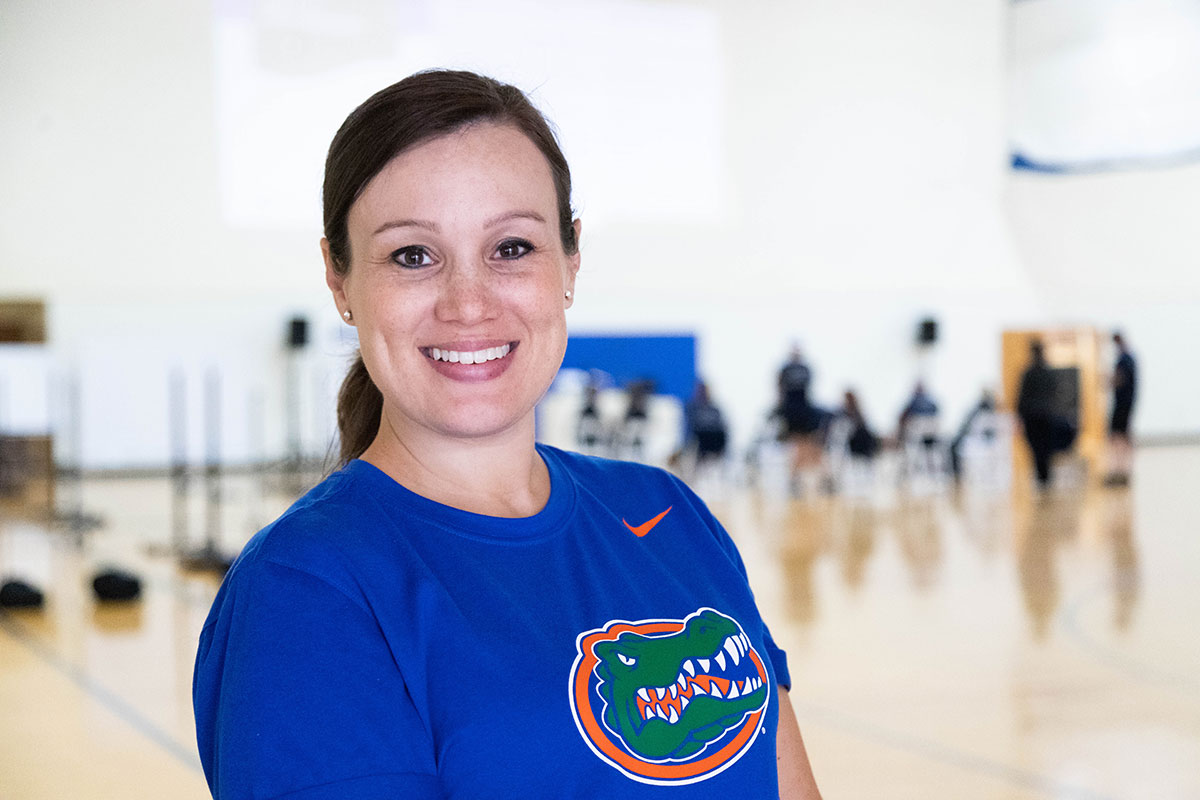 HHP - Update me in site_config > General Configuration
HHP - Update me in site_config > General Configuration

Anna Gardner, Ph.D., instructional assistant professor in applied physiology and kinesiology (Brianne Lehan)
May 18, 2022
Gardner, alongside other APK faculty, helped train a handful of members from Alachua County Fire Rescue (ACFR) on becoming Peer Fitness Counselors (PFC) for their fire department in the Florida Gym this spring.
As counselors, they can assist their coworkers in reaching ideal fitness goals when it comes to passing physical screenings and being prepared for the line of duty.
Gardner originally started the initiative back in 2013 to educate counselors as part of her Ph.D. dissertation. She aimed to contribute to a more standardized department-wide fitness approach, while also providing targeted education and counseling for those firefighters at greater risk of poor health outcomes. Gardner recognized the vital role fire rescue plays in saving lives when danger comes unexpectedly.
“It’s a way for me to take my expertise and give back to these people that obviously do so much for the community,” Gardner said.
But Gardner said she wouldn’t be able to do it without the help of Ben Gordon, Ph.D., and Blain Harrison, Ph.D., instructional assistant professors in applied physiology and kinesiology. Together, the professors helped realize the program through presentations on the health risks firefighters endure as well as the exercise programming that could help keep them in shape.
They emphasized the use of easy-to-access equipment to simulate the hose line and ladder carries rescuers need to do on standardized occupational tests such as the Fireground Physical Ability Test. Whether through bear crawls, medicine balls or rope pulls, ACFR members can exercise properly with even the most basic resources. The goal for the counselors would be to prescribe the right training for a rescuer based on their current fitness.
Misty Woods, assistant chief at ACFR, was one of the returnees from 2013. Since then, she said a change in department equipment and fitness requirements as well as staff overturn has made a refresher necessary.
“That’s our job to help protect people,” said Woods. “If we’re not physically fit to do that then we’ve failed our duty from the get-go.”
Gardner hoped to catch past trainees up to speed while introducing newer members to fitness concepts that they can teach back in the firehouse such as a functional movement screen (FMS) to test mobility, stability and strength.
“If they can change the morale to where fitness is deemed as more important and people are jumping on board, then I think that will go a long way in terms of getting their peers to be more physically active as well,” Gardner said.
Kenny Marr, a driver operator paramedic, experienced the program for the first time. He noted the abundance of literature showing the hazards firefighters face. They inhale dangerous toxins from fires and even from the tools they use. Rescuers also often fall short on good sleep and healthy meals while serving the public, he said.
“This is a way for me to help all of my colleagues live a longer and fuller life with their families on top of the fact that we're trying to give the citizens the best that we have,” Marr said.
 Marr (right) shares a laugh while practicing exercises with a medicine ball April 9 in the gymnasium. (Brianne Lehan)
Marr (right) shares a laugh while practicing exercises with a medicine ball April 9 in the gymnasium. (Brianne Lehan)
 Woods writes out an exercise prescription for a hypothetical ACFR member April 9 in the gymnasium (Brianne Lehan)
Woods writes out an exercise prescription for a hypothetical ACFR member April 9 in the gymnasium (Brianne Lehan)
--
Comment / Like / Share - Connect with #UFHHP
FACEBOOK │ INSTAGRAM │ LINKEDIN │ TWITTER
--